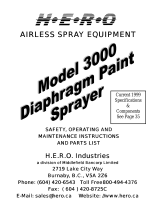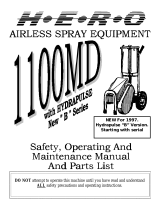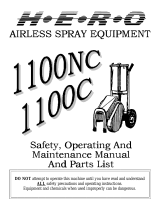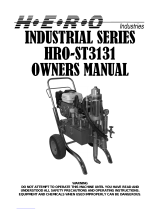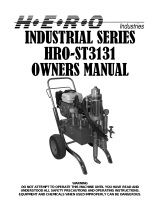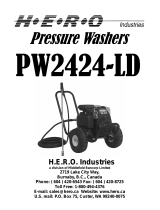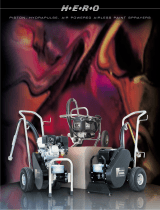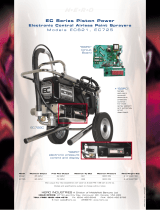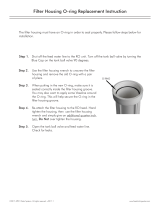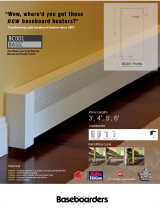Page is loading ...

H.E.R.O. INDUSTRIES 300S / 300SL LEGEND Owner’s Manual
1
AIRLESS SPRAY EQUIPMENT
H.E.R.O. IndustriesH.E.R.O. Industries
a division of Middlefield Bancorp Limiteda division of Middlefield Bancorp Limited
2719 Lake City Way2719 Lake City Way
Burnaby, B.C., V5A 2Z6Burnaby, B.C., V5A 2Z6
Phone: (604) 420Phone: (604) 420--65436543 ToToll Freell Free 800800--494494--43764376
Fax: ( 604 ) 420Fax: ( 604 ) 420--8725C8725C
EE--Mail: [email protected]Mail: [email protected] Website: //www.hero.caWebsite: //www.hero.ca
SAFETY, OPERATING ANDSAFETY, OPERATING AND
MAINTENANCE INSTRUCTIONSMAINTENANCE INSTRUCTIONS
AND PARTS LISTAND PARTS LIST

H.E.R.O. INDUSTRIES 300S / 300SL LEGEND Owner’s Manual
2
H.E.R.O. WARRANTY
H.E.R.O. INDUSTRIES , guarantees this airless pump to be free of defects in
materials and workmanship to the original owner, for a period of one full year
from the date of purchase.
The warranty entitles the owner to parts replacement at no charge. The parts
replacement warranty is valid for any necessary replacement, whither caused
by material or workmanship defect or simple wear. H.E.R.O. Industries offers
no warranty on the intake ball, outgo ball, drive belt, hoses, gun or
accessories, plastic, rubber, other soft goods or motor used in or supplied with
the H.E.R.O. sprayer.
Motor, accessories, etc., which are supplied by other manufacturers and are
attached to or supplied with the H.E.R.O. airless pump, are warranted only to
the extent that these parts are warranted by their respective manufacturers.
Warranty claims must be made directly to such manufacturers or their local
authorized service depots.
The warranty is only applicable to the original purchaser and the equipment
has been properly used, operated and maintained in accordance with all
instructions, precautions and warnings contained in this manual. For the
purpose of this warranty, damage resulting from accident, abuse, improper
cleaning or operation, fire, flood, or Act of God, is not covered.
H.E.R.O.’s liability is limited to replacing parts found to be defective or worn
and does not include; transportation costs, damage or other expenses of any
kind incurred in connection with the purchase and use of this sprayer.
Repairs claimed under warranty must be performed at an authorized H.
E.R.O. Service Center, using only genuine H.E.R.O. parts. Parts necessary
under warranty claim will be supplied by your local H.E.R.O. Service Center.
DO NOT return worn parts to factory without authorization.
To qualify for the warranty, the warranty card (attached to this page) supplied
with this H.E.R.O. airless pump, must be completed with equipment serial
number and signed by the purchaser, and postmarked within ten (10) days of
purchase.

H.E.R.O. INDUSTRIES 300S / 300SL LEGEND Owner’s Manual
3
Table of Contents
Important Safety Precautions 4 – 5
Introduction 6
Operating Instructions 6
Setting up to Spray 7
Flushing The Unit 8
Special Notes 9
Airless Spray Painting Suggestions 10 – 13
Trouble Shooting 14 – 22
Intake Seat Replacement 23
Outgo Valve 24
Bleed Valve Repairs 25
Diaphragm Replacement 26
Hydraulic Head Insert Replacement 27
Piston Repairs 28 – 29
Pressure Control Valve Repairs 30
Accessories 31
Parts List & Description 32 – 36
Exploded Unit Schematics 37 – 38
IMPORTANT
AS WITH ALL MECHANICAL EQUIPMENT, PROPER OPERATING AND MAINTENANCE
PROCEDURES ARE REQUIRED TO KEEP YOUR H.E.R.O. AIRLESS PUMP PERFORMING
TO YOUR SATISFACTION. THE FOLLOWING SAFETY, OPERATING AND MAINTENANCE
INSTRUCTIONS ARE IMPORTANT.
Read and understand this manual completely, especially with regard to all safety precautions. Read and
follow instructions on all warning labels on your equipment. Keep the warning labels clean and readable at
all times. Order new labels from your local distributor or from H.E.R.O. Industries if needed.
The manufacturer shall not be responsible for any loss, damages, or injury of any kind or nature whatsoever
resulting from the use the equipment other than in strict compliance with the instructions, cautions and
warnings contained in this operating and instruction manual and as displayed on the face of the equipment.
This system is capable of producing 2400 psi. ( spray pressure ). To avoid rupture and injury DO NOT
operate this pump with components rated less than 3000 psi. working pressure (including but not limited to
spray guns, hose and connections).
Before servicing, cleaning or removing of any part, shut off power and relieve pressure.

H.E.R.O. INDUSTRIES 300S / 300SL LEGEND Owner’s Manual
4
IMPORTANT SAFETY PRECAUTIONS
WARNING
Material issuing from the spray tip is at high pressure. If fingers, or any part of the body are placed near
the tip of the spray gun, it is possible that the spray could break the skin and inject some of the spray
material. If injury does occur, seek immediate attention of a medical doctor. Be prepared to inform the
doctor what fluid was injected, if the injury is of an injection nature. Equipment and chemicals when
used improperly can be dangerous!
ý NEVER place any part of the body in front of the spray tip or aim the gun toward any part of the
body.
ý NEVER point the gun toward any individual.
ý NEVER treat any injury as a simple cut. If injury does occur, seek immediate medical attention. Be
prepared to inform the doctor what fluid was injected.
ý NEVER allow another person to use the sprayer unless he is thoroughly instructed on its operation
and has read all safety precautions in this manual and all safety warning labels attached to unit.
ý NEVER use around children.
ý NEVER attempt to perform any maintenance or service on any part of the unit spray system without
first;
1. Shutting off the unit.
2. Disconnecting the power cord from the outlet.
3. Relieving all pressure in the pump by triggering the gun.
4. Locking gun trigger in "LOCKED" position, with gun locked closed.
ý NEVER operate the sprayer without the tip guard complete and in place.
ý NEVER spray any material in the vicinity of open flame, pilot lights, electrical outlets or any other
source of ignition.
ý NEVER spray volatile materials with flash points lower than 140 F (60 C).
ý NEVER attempt to stop any leakage in the paint line or at any fitting with your hand or any part of
your body. Immediately shut off the unit should leakage occur.
ý NEVER wash an electric motor, nor operate it in the rain or in wet or damp areas, to protect yourself
from electric shock.
ý NEVER allow paint hose to become kinked, or to vibrate against rough or sharp surfaces.
ý NEVER operate the unit at pressures higher than the pressure rating of the lowest rated component
in the system, or at pressure higher than factory preset.
ý NEVER spray in an enclosed area. The spraying area must be well ventilated to safely remove
chemical vapors.
ý NEVER operate the unit with worn or damaged accessories, or with accessories other than those
supplied by H.E.R.O. Industries, unless the accessories have been first specifically approved in
writing by H.E.R.O. Industries.
ý NEVER allow the unit to be serviced or repaired anywhere other than an authorized H.E.R.O.
Service Center, or with other than genuine H.E.R.O. parts or components.
ý NEVER leave unit unattended without first shutting off, triggering the gun to relieve all pump
pressure, and setting the trigger lock on gun in "LOCKED" position, with gun locked closed.

H.E.R.O. INDUSTRIES 300S / 300SL LEGEND Owner’s Manual
5
ALWAYS
þ ALWAYS follow H.E.R.O. recommendations for operation and safety completely.
þ ALWAYS ensure that switch is in off position before plugging in the electric motor.
þ ALWAYS set trigger lock on gun in "LOCKED" position when not in use, with gun locked close.
þ ALWAYS check connections and fittings for tightness before operating the unit.
þ ALWAYS locate the unit in a well ventilated area a minimum of 25 feet from the spray area.
þ ALWAYS ground the unit, the paint containers, and the object being sprayed to eliminate static
discharge. Ensure that all these objects remain grounded throughout the entire spraying operation.
þ ALWAYS use approved 3 prong grounded extension cord and approved grounded outlets of the
voltage and frequency specified on the motor. The outlet must be at least 25 feet from the spraying
area.
þ ALWAYS use approved 3 prong grounded extension cord not less than # 12/3 gauge up to 50 feet,
and not less than # 10/3 gauge up to 100 feet. DO NOT exceed 100 feet of extension cord.
þ ALWAYS use accessories and components approved for at least 3000 psi (working pressure) in the
spraying system.
þ ALWAYS use accessories and components supplied by H.E.R.O. Industries, or specifically
approved in writing by H.E.R.O. Industries on with the unit
þ ALWAYS examine accessories for wear or damage before operating the unit
þ ALWAYS use lowest possible pressure when flushing and cleaning the unit, and hold the gun firmly
against a metal container to reduce static discharge possibility.
þ ALWAYS wear a face filter mask when operating the unit.
þ ALWAYS ;
1. Turn off the motor
2. Disconnect the power cord from the outlet.
3. Relieve all pressure in the pump by triggering the gun.
4. Lock gun trigger in "LOCKED" position, with gun locked closed before attempting to perform any
maintenance or service on any part of the unit spray system.
þ ALWAYS wear safety glasses when operating the unit.
þ ALWAYS ensure fire extinguishing equipment is readily available and properly maintained in the spray
area.
þ ALWAYS observe good housekeeping and keep the spray area free from obstructions.
þ ALWAYS be aware that certain chemicals may react with aluminum, carbide, or other components in
the pump system. Read the manufacturer's label on all materials to be sprayed, and follow the
manufacturer's recommendations. If in doubt, consult your material supplier to be sure.

H.E.R.O. INDUSTRIES 300S / 300SL LEGEND Owner’s Manual
6
H.E.R.O. AIRLESS SPRAY PAINTING
Welcome to the world of H.E.R.O. airless paint spraying. We are sure you will enjoy owning and operating
your new H.E.R.O. model 300S or 300SL. With H.E.R.O. airless spray equipment you will avoid the
inconvenience and mess of over spray. You are spraying paint, not air, and the paint is driven to the painting
surface in a clean, fan shaped spray which penetrates all cracks and corners. To attain these results, you must
adjust the pressure as low as possible. We recommend that you become familiar with your H.E.R.O. unit.
Discuss with your dealer the useful accessory items he has to offer - various types of tips, extension poles for
hard to reach areas, extra hose, etc. Use of accessory items is often the difference between a good job and an
excellent one!
OPERATING INSTRUCTIONS
WARNING
Do not attempt to operate this machine until you have read and understood all safety precautions and
operating instructions. Equipment and chemicals when used improperly can be dangerous.
Your H.E.R.O. airless sprayer has been fully factory tested prior to shipment.
BEFORE STARTING YOUR H.E.R.O. PUMP....
CHECK to ensure that the shipping seal has been removed from under the cap on the hydraulic tank.
Hydraulic tank should be at least 3/4 full of H.E.R.O. LVO hydraulic fluid.
CHECK all fittings and connections in the pump system, hose, and gun to ensure that they are tight.
CHECK to ensure that there is a spray tip in the gun, and that the tip is the correct size for the coating you
are to spray. ( There are various tips available, for each type of coating or configuration. See " Airless Spray
Tip " on page 12/13 , for proper tip selection.
CHECK to ensure that you have H.E.R.O. strainer bags, H.E.R.O. Wonder Wash, appropriate thinner for
the paint, a waste container, and any other accessories you may require for the job.
CHECK to ensure that you have adequate extension cord size and length if the machine cannot be situated
immediately next to an electric outlet. Distances up to 50 feet require #12/3 wire grounded cord, up to 100
feet require #10/3 wire grounded cord. DO NOT exceed 100 feet of extension cord. If distance is greater,
obtain and install extra length of H.E.R.O. airless spray hose.
READ THIS MANUAL THOROUGHLY.

H.E.R.O. INDUSTRIES 300S / 300SL LEGEND Owner’s Manual
7
SETTING UP TO SPRAY
1 Remove unit from shipping carton. Inspect exterior of unit for any signs of
freight damage. If any parts are found to be broken or damaged, immediately
contact the carrier and arrange for an inspection of the concealed damage.
Claims for freight damage must be made by the CONSIGNEE and not by the
shipper. The carrier accepts full responsibility for the safe delivery of
merchandise upon pick-up from the shipper.
2 Attach intake hose assembly (ref# 1) onto hose barb (ref# 7). Tighten clamp (ref#
6 ) securely.
3 Attach prime hose (ref# 48) to prime valve (ref# 44). Secure with clamp (ref# 49).
4 Attach paint hose to outgo tee (ref# 33).
5 Attach gun to paint hose. NOTE; Spray tip and tip guard should be attached to
gun prior to attaching to hose.
6 Place intake siphon assembly into a clean 5 gallon pail.
7 Install strainer bag (accessory item 5GAL SB) in pail and secure with large rubber
band ( accessory item 106). NOTE; Strainer bag must remain 4 inches from the
bottom of pail
8 Trigger gun to release any pressure in the unit. Use extreme caution to ensure that
the gun is not directed towards anyone or any object which may be damaged.
NOTE; Unit may contain storage solution.
9 To remove storage solution, add one gallon of thinner, compatible with the type of
paint to be used, to the siphon pail.
10 Turn pressure control handle (ref# 43) counter clockwise to lowest pressure setting.
11 Be sure motor switch is in "OFF" position. Plug unit into 115V, 15 amp., grounded
circuit. NOTE; If using an extension cord, you MUST use a #12/3 wire
grounded cord, up to 50 feet or #10/3 wire grounded cord, up to 100 feet. DO
NOT EXCEED 100 FEET OF EXTENSION CORD. If distance is greater,
purchase and install additional lengths of airless spray hose.
12 Turn motor switch "on".
13 Turn prime valve handle (ref# 43) counter clockwise until fully open. Allow
thinner to circulate back into the siphon pail for a few minutes. Then turn the prime
valve knob clockwise to close the valve ( close tightly ), and direct the flow to the
paint hose and gun. Leave the pressure setting low.
14 Trigger gun into waste container.
15 Pour paint through strainer bag into siphon pail.
16 Repeat steps 13 and 14, until paint flows freely. NOTE; Never turn prime
valve back to "prime" position when the unit is under pressure.
17 Spray a test pattern. Begin by spraying a test pattern onto old newspaper or
other scrap material.
18 Increase the pressure, slowly at first, by turning the pressure control knob
clockwise. Continue increasing the pressure until the spray pattern is uniformed
from top to bottom, with no heavy areas. Secure pressure control setting, by
turning the silver lock ring (ref# 76) counter clockwise until snugly against the
face of the pressure control knob. If heavy areas are still visible at maximum
pressure setting, thin the paint with the correct thinner, according to the paint
manufacturer's recommendations.

H.E.R.O. INDUSTRIES 300S / 300SL LEGEND Owner’s Manual
8
If shutting down for a short period of time, it is sufficient to trigger the gun
to relieve pressure. Then set the safety lock on gun to "locked" position with
the gun locked closed and immerse the gun in a container of the correct
thinner for the paint you are spraying.
1. Remove spray tip from gun.
2. Turn pressure control knob counter clockwise to low pressure setting.
Only use sufficient pressure to allow material to move through the
sprayer. DO NOT operate at or near full pressure.
3. Remove siphon assembly from paint container.
4. Trigger gun, back into paint container, until unit runs dry.
NOTE: Pump and spray hose will continue to contain paint. This paint
may be recovered by placing prime hose into paint container and draining
the remainder while re-priming with cleaning fluid. See step 5* and 6*.
5. Place siphon assembly in container of correct thinner, for the spray
product being used,, and prime the pump as shown in step 13, of
"Spraying". *See special notes from step 4. Allow thinner to circulate
back into the container for a few minutes to flush the prime valve.
6. Close prime valve.
7. Trigger gun into paint container until thinner comes through. *See special
notes from step 4. Re-direct flow into waste container and continue
spraying until thinner runs clear. Heavily soiled thinners may have to be
changed to complete cleaning job.
8. Lift siphon assembly and allow pump to run dry.
9. Repeat procedure using a gallon of H.E.R.O. Equipment Wonder Wash
solution. If not using Wonder Wash, unit must not be stored with water.
Only store with a non corrosive material ( Paint thinner, solvent ).
10. Switch unit "off" and trigger gun to relieve remaining pressure.
11. Remove and rinse gun handle filter in correct thinner.
SPECIAL STORAGE INSTRUCTIONS
In areas where the sprayer is NOT used 12 months of the year, special
preparations must be used for winter or off season storage. Because solvents
evaporate quickly, they should not be used for long term storage. A petroleum
based solution ( solvent and oil ) should be used as an extended storage
material. DO NOT allow storage solution to freeze in the sprayer.
H.E.R.O. Equipment Wonder Wash, available from your H.E.R.O.
distributor, will provide the added cleaning benefits of solvent at a much
lower cost. Suitable as a short term ( 1-2 days ) storage solution only
FLUSHING THE UNIT AT SHUTDOWN
OR COLOR CHANGE

H.E.R.O. INDUSTRIES 300S / 300SL LEGEND Owner’s Manual
9
SPECIAL NOTES AND INSTRUCTIONS
NEVER LEAVE THE UNIT UNDER PRESSURE WHEN NOT SPRAYING (MOTOR TURNED
OFF). RELIEVE PRESSURE BY TRIGGERING GUN. NEVER STORE THE UNIT WITH PAINT
OR WATER IN THE PUMP SYSTEM, EVEN OVERNIGHT.
ý NEVER attempt to start the motor when the unit is under pressure. Relieve pressure and follow
instructions in "Setting up to spray"
ý NEVER attempt to run the motor on longer or lighter extension cord than specified.
ý Avoid operating the unit while tilted. Keeping it level assures greater operating efficiency.
þ If motor's thermal overload switch has opened, unplug unit and allow it to cool.
ý DO NOT attempt to resume spraying before determining and correcting the cause of overheating.
þ Always follow flushing and cleaning instructions exactly.
þ In hot weather, locate unit in shade.
þ Regularly check the level of H.E.R.O. LVO hydraulic fluid in the hydraulic tank. It should be kept near
full, top up as needed with only genuine H.E.R.O. LVO hydraulic fluid.
þ Crankshaft eccentric bearing should be greased at regular intervals consistent with hours of use. Use
MO-2 grease ( i.e. common auto grease) approximately every 10 hours of operation.
þ If you wish to power your H.E.R.O. airless sprayer with a generator, it must be a minimum of a 4500
watt generator, in good operating condition.
NOTE; An electric tool must be powered by a generator which has an output wattage of at least three
times the maximum draw of the motor under full load.
þ A minimum 50’ and a maximum of 300’ of airless spray hose may be used.
NOTE: 50’ x 3/8” paint hose ( part # 117 ) should be used for every 50’ x 1/4” paint hose
( part # 114 ) over 100’.
100’ total length of paint hose = 2 of 50’ x 1/4” paint hose.
150’ total length of paint hose = 2 of 50’ x 1/4” paint hose and 1 of 50’ x 3/8 paint hose.
200’ total length of paint hose = 2 of 50’ x 1/4” paint hose and 2 of 50’ x 3/8 paint hose.
250’ total length of paint hose = 3 of 50’ x 1/4” paint hose and 2 of 50’ x
3/8 paint hose.
300’ total length of paint hose = 3 of 50’ x 1/4” paint hose and 3 of 50’ x 3/8 paint hose.
þ Product viscosity, altitude ( feet above sea level ) and vertical reach can effect pump performance and
special accessories may be required. Product viscosity may have to be further reduced at higher
elevations. Special “ High Altitude” siphon assemblies ( part # 4-210-HA ) are available for use in
areas at or above 5000 feet above sea level. This kit may also prove beneficial if spraying thicker
viscosity materials. The larger diameter 3/8” paint hose should also be used.
þ Check drive belt ( part # 66/100 ) tension frequently. The belt will stretch with use, and should be
adjusted after 20 hours of operation and again after 50 hours. Periodic checks after 50 hours should be
made. Failure of the drive belt is not covered by the equipment warranty, so proper maintenance of the
belt is important.
þ Regularly check fittings, bolts, nuts and connections for damage. Tighten, adjust or replace as required.
þ Check crankshaft alignment often. An out of alignment crankshaft will cause the damage to the
eccentric bearing.

H.E.R.O. INDUSTRIES 300S / 300SL LEGEND Owner’s Manual
10
AIRLESS SPRAY PAINTING
SUGGESTIONS AND TECHNIQUE
A good airless spray application is the result of many factors. Surface preparation, which includes cleaning
and degreasing, priming, material compatibility, quality finish product and correct application technique, are
all important to the finished results.
The key to all good applications is a good spray gun technique. The finished results are what the client will
look at and base his opinion on. Your skill and abilities are as important as good equipment and good paint.
Proper application techniques can easily be learned by using the following simple guidelines. If you are not
familiar with the basic spray techniques we recommend that you study this portion of the manual and
practice the techniques shown. Practice your technique on scrap cardboard or old newspaper until you feel
confident.
FOR EXCELLENT RESULTS, READ AND PRACTICE THESE TECHNIQUES
1. Always strain all paint through a H.E.R.O. strainer bag.
The most common reason for airless sprayers to malfunction is foreign matter jamming the valves or
plugging the tip. Always strain the paint before putting through the pump.
2. Always spray at the lowest pressure setting which will provide a uniform spray fan. (fig. 1, page 11)
Adjust pressure control knob so that paint is completely atomized . Insufficient pressure will result in
"tailing". Too much pressure will result in excess fog and over spray, excess tip wear, and increased
sprayer wear and tear. See setting up to spray, page 5.
3. Always spray at right angles to the surface being sprayed. (fig. 2, page 11)
Angling or arcing the nozzle toward the surface will cause uneven coverage and excessive over spray.
4. Always hold spray gun 12-15 inches from spray surface. (fig. 3, page 11)
Too close and the fan width will be reduced and material will be applied too heavily (runs).
Too far from the surface and you will have excessive over spray and light coverage (transparent).
5. Always move the gun parallel to the surface being sprayed, at a consistent speed.
This avoids uneven coverage (thick or thin areas).
6. Always start the spray stroke before triggering the gun and release the trigger before completing the
stroke. (fig. 4, page 11)
This avoids heavy build up of paint at either end of the spray stroke.
7. Always lap your spray pattern by one half. (fig. 5, page 11)
This assures full coverage of the surface being painted.

H.E.R.O. INDUSTRIES 300S / 300SL LEGEND Owner’s Manual
11
AIRLESS SPRAY PAINTING
SUGGESTIONS AND TECHNIQUE
Poor Good Tailing Good Pattern Fog, Over Spray
FIG. 1
FIG. 2 FIG. 2
FIG. 3
FIG. 4
FIG. 5

H.E.R.O. INDUSTRIES 300S / 300SL LEGEND Owner’s Manual
12
AIRLESS SPRAY PAINTING SUGGESTIONS AND TECHNIQUE
SPRAY TIP SELECTION
TIP SIZE FOR APPLICATION OF
.021 Exterior Latex on large unobstructed areas. (max. size allowed) ( 60 OZ. )
.018 Interior Latex, Exterior Latex, Shake Paint, Exterior Flat Paints. ( 46 OZ. )
.015 Alkyd Flat Enamel, Interior Latex, Semi-Gloss Enamel, Stains. ( 30 OZ. )
.013 Fine ground Gloss Enamels, and good quality Stains. ( 23 OZ. )
.011 Clear Varnishes and Lacquers. ( 15 OZ. )
.009 Clear Varnishes and Lacquers. ( 10 OZ. )
NOTE: The above volumes achieved with gun wide open for 1 minute and pump spraying at 2000 psi.
All volumes are approximate. To test worn tips, spray water through the tip at 2000 psi. for 1 minute.
Spray into bucket and weigh amount (less weight of bucket). If it is substantially greater than what is
listed above, then the tip should be discarded or reclassified. As a tip wears, the hole gets larger and the
fan pattern becomes narrower.
ORIFICE SIZE
All tips are rated by the size of the orifice or bore size. The bore size is measured in thousandths of an inch
( .018 = 18 thousandths of an inch ). The size of tip required is based on the consistency of the material to be
sprayed. The thicker the paint, the larger the tip size required. Always consult the product label or ask the
paint retailer for the manufacturer's recommendations with regard to proper tip sizes.
FAN WIDTH
Fan width or pattern width is determined by the spray tip's "fan width" classification. This size is measured in
inches, and is determined when spraying 12 inches from the spray surface. Various methods of noting the fan
widths are used by tip manufacturers. Ask your distributor for assistance.
NOTE: Two tips having the same tip size, but different fan widths will deliver the same amount of paint
over a different area (wider or narrower strip). A spray tip with a narrow pattern width makes it easy to
spray in tight places. Use only good quality, high-pressure tungsten carbide spray tips.
SPRAY TIP REPLACEMENT
During use, especially with Latex paint, high pressure and material abrasion will cause the orifice to grow
larger. As the orifice grows larger, the fan width grows smaller. Replace tips before they become excessively
worn. Worn tips waste paint, cause over spray, make cutting in difficult, and decrease sprayer performance.
NOTE: When using Latex paint, a spray tip will wear at the rate of one size for approximately every 100
gallons of material sprayed.
An excessively worn tip can be the cause of apparent operating problems with the unit. If a tip is worn
past the aperture size which the unit can support, pulsation will become evident in the spray fan/pattern.
Added strain is placed on the Hydrapulse membrane as it attempts to keep the spray pressure consistent.
When the tip wears beyond .021, its is releasing more material than the unit is bringing in. The natural
reserve of product in the paint chamber is reduced and harm to the membrane begins. ALWAYS check
your tips for wear when trouble shooting the equipment. The 300S/SL can support up to a maximum of
a .021 tip.

H.E.R.O. INDUSTRIES 300S / 300SL LEGEND Owner’s Manual
13
AIRLESS TIP’S FLOW RATE ( GALLONS PER MINUTE )
Orifice Size
In Inches
GPM
Flow Rate
Orifice Size
In Inches
GPM
Flow Rate
.007 .05 .018 .35
.009 .08 .019 .40
.011 .12 .021 .47
.013 .18 .023 .57
.015 .23 .026 .72
.017 .30 .031 1.1
AIRLESS TIP RECOMMENDATIONS
COATINGS COATING
VISCOSITY
FILTER
MESH
ORIFICE
SIZE *
Varnishes Light Body 100 – 150 .009, .011
Lacquer Finishes (clear) .009, .011
Sanding Sealers .009, .011
Shellac (clear) .009, .011
Transparent Stain .011, .013
Water Sealers (clear) .011, .013
Solid Stains Medium Body 60 – 100 .013, .015
Exterior House Paint .013, .017
Interior Wall Paint .015, .017
Interior & Exterior Primers .017, .019
Commercial Grade Architectural Coatings:
Interior Wall Paints Heavy Body 30 – 60 .017, .019
Interior Wall Primers .017, .019
Dry Fall (Quick Dry) .019, .023
One Coat, Primer-Finish Paints .019, .023
Elastomerics Extra Heavy .021 – .031
Pigmented Water Proofer’s .021 – .027
Block Filler .025 – .031
* Fan width between 8 and 12 inches.
SPRAY TIP SELECTION

H.E.R.O. INDUSTRIES 300S / 300SL LEGEND Owner’s Manual
14
TROUBLESHOOTING
Hydraulic Energy Regulated Output (H.E.R.O.) is more than just our name, it is the bases for the
operation of the pump. It is the regulation or control, of hydraulic energy, which allows the equipment to
build and then deliver or have an output of pressure. Once you have a basic understanding of the operation of
the equipment and the effect created in one area and how it will effect operation in another area, you will be
better able to diagnose and make repairs.
All H.E.R.O. diaphragm pumps are made up of two (2) distinct pumps. The first, and most important
pump is the hydraulic pump. The hydraulic system is made up of two valves, the hydraulic intake valve (ref#
62) and the hydraulic outgo valve, known as the hydraulic pressure control valve (ref# 73). The second pump
is known as the paint or material pump. The paint system is made up of two basic valves, the paint intake
valve assembly (ref# 11-15), paint outgo valve, (ref# 22). A third valve, known as a prime valve (ref# 34) is
used during the priming procedure, (see "setting up to spray"). For correct operation, all five valves must be
in good working condition. For this manual we will refer to the two systems as "hydraulic" and "paint".
At the center of these two pumps is the diaphragm. The diaphragm is a flexible nylon disc which transfers
the energy (pressure) created by the hydraulic pump, to create energy (pressure) in the paint pump. The
function of the diaphragm is to create a barrier between the hydraulic oil and the spray material and transfer
the energy created.
To fully understand and trouble shoot a H.E.R.O. pump, always keep in mind that "for every action,
there is an opposite or corresponding re-action". For every action of the hydraulic intake valve (ref# 62),
there is an opposite re-action of the hydraulic outgo valve (ref# 73). At the same time there are
corresponding re-actions taking place within the paint pump. This means that as the hydraulic intake valve is
opening, so is the corresponding paint intake valve, and while the hydraulic outgo valve is closing, so is the
corresponding paint outgo valve. The operation and function of each valve is discussed at the end of this
section.
For correct operation to begin, the hydraulic system must be fully primed and all air must be removed
( see "purging" page 19 ). Operation begins with piston in the backward position (fig.# 2). At this point the
hydraulic intake is open, while the hydraulic outgo valve is closed. The corresponding paint valves are in
similar positions.
As the piston moves forward, it pushes hydraulic oil forward. This movement of oil causes the hydraulic
intake valve to close and the diaphragm to move forward (fig.# 1). The hydraulic outgo valve will remain
closed until sufficient pressure is created to cause it to open. While the hydraulic valves are operating a
corresponding re-action is taking place in the paint valves. The forward movement of the diaphragm pushes
the paint, causing the paint intake valve, (ref# 11-15) to close. The trapped paint requires a means of release,
so it forces the outgo valve, (ref# 22), to open and paint flows to the gun.
Fig. 1
Fig. 2

H.E.R.O. INDUSTRIES 300S / 300SL LEGEND Owner’s Manual
15
TROUBLESHOOTING
The backward movement of the piston, creates a vacuum in the hydraulic system. This causes the
hydraulic outgo valve to close and the hydraulic intake valve to open (fig# 1). Opening of the hydraulic
intake valve allows a new supply of hydraulic oil to enter the system, replacing the oil which was used on the
forward stroke. Once again a corresponding re-action is taking place in the paint pump. The diaphragm is
pushed backward by the paint intake spring, (ref# 15). The backward diaphragm movement causes a vacuum
in the paint pump. This vacuum causes the intake valve to open, allowing a new supply of paint to enter. The
corresponding paint outgo valve is drawn closed by the vacuum created by the diaphragm.
These operations are repeated at a rate of 750 times a minute. These continuously repeated actions draw
paint into the pump, pressurize it, and then deliver it to the gun. The failure, of any one valve, to operate
correctly will effect the overall equipment performance.
Each of the five valves mentioned earlier, have an important function and will effect the overall
performance of the unit if not performing correctly.
HYDRAULIC INTAKE VALVE (REF# 62, PART # 4-30)
The hydraulic intake valve, is a small vacuum valve which controls the hydraulic oil entering the
hydraulic pump/cylinder area. Once the oil has past through the valve it is prevented from returning. The
valve is commonly called a “one way check valve”. Valve failure will result in the hydraulic pump being
unable to build pressure, and the diaphragm will stop moving. Spray pressure will cease.
HYDRAULIC OUTGO VALVE (REF# 73, PART # 4-27C)
The hydraulic outgo valve, better known as the "pressure control valve", is used to control the units
operating pressure. The valve is fully adjustable from 0 psi. to 3000 psi. By turning the pressure control valve
knob (ref# 74) clockwise the pressure is increased. The hydraulic pump continues to build at all times and
must have a means of releasing this pressure. Pressure applied to the P.C. ball, (ref# 87) will keep it lodged
in the P.C. seat (ref# 86) until the internal hydraulic oil pressure is sufficient to cause it to open. The point at
which the oil is released is equal to the level set by the control knob. As components within the pressure
control valve wear, the valve looses its ability to maintain or reach the required pressures (see "low static
pressure").
PAINT INTAKE VALVE ASSEMBLY (REF# 11-15)
The paint intake valve is made up of five items, endcap (ref# 11) complete with seat (ref# 12), intake
ball (ref# 13), cage complete with spring (ref# 14), and large spring (ref# 15). The intake valve controls the
incoming flow of spray materials and is responsible for keeping them from returning to the source. The ball
must be able to create a complete seal on the seat, otherwise pressure will be lost. A worn intake valve will
permit correct static pressure, but supply lower spray pressure. A worn intake ball will become smaller in
diameter and loose its ability to seal at the seat. A worn seat will develop a large step in the area where
contact with the ball is made. This can cause the intake ball to distort in shape making the ball egg shaped. If
the valve assembly becomes warm to the touch, this may be a sign of a loose or worn seat or erosion / wash
out of the endcap block. The seat is Loc-Titeed into the endcap and must remain tightly sealed at all times.

H.E.R.O. INDUSTRIES 300S / 300SL LEGEND Owner’s Manual
16
TROUBLESHOOTING
PAINT OUTGO VALVE (REF# 22, PART # 4-11A)
The paint outgo valve monitors and controls the flow of spray materials as it leaves the sprayer. It also
works together with the paint intake valve, to build paint pressure as specified by the setting made by the
hydraulic outgo valve (pressure control valve). A worn outgo valve will result in pulsation in the spray
material and cause the paint hose to jump and vibrate vigorously.
PRIME VALVE (REF# 34, PART # 4-606 – NEW)
The prime valve is used at the beginning and end of the spray operation (see "setting up to spray"). The
function of the prime valve is to assist in removing air from the paint pump when beginning to spray. It is
necessary to remove all air from the paint pump so that the spray material can replace it. The pump will
function without the prime valve, however, the initial priming procedure would require considerably longer
to complete. During the priming procedure the diaphragm is exposed to its greatest amount of stress. Use of
the prime valve and a lightweight thinner, which is compatible with the intended spray material, will reduce
diaphragm stress and reduce priming time. The prime valve will also allow you to remove any unused paint
left in the pump and hose at the completion of a job. When the prime valve is open the material is pumped
through the paint intake and outgo and back to the source by way of the prime valve return hose. When
closed, no material should be escaping from the prime valve return hose (ref# 48). If material escapes
through the prime valve return hose, when the valve is closed, spray pressure at the gun will be reduced.
The solution to almost all problems can usually be found in the paint side valves. However, before
performing any repair or looking further, the following are things which can cause an apparent sprayer
failure, without any mechanical problem. ALWAYS check these items before preceding.
1. Circuit breaker open or fuse blown. 9. Gun handle filter plugged.
2. Motor not plugged in. 10. Paint hose plugged.
3. Motor not switched on. 11. Loose fitting or hole in siphon hose.
4. Motor thermal reset popped. 12. Intake siphon hose plugged.
5. Too light or too long of an extension cord. 13. Siphon screen missing or plugged.
6. Pressure control knob loose or missing. 14. Sprayer under pressure when restarting.
7. Spray tip plugged. 15. Strainer bag plugging siphon screen.
8. Spray tip worn out.
UNLESS YOU ARE KNOWLEDGEABLE ABOUT THE REPAIR OF HIGH PRESSURE
EQUIPMENT, DO NOT ATTEMPT TO REPAIR AN AIRLESS SPRAYER YOURSELF. ALWAYS
FOLLOW ALL SAFETY PRECAUTIONS. THE H.E.R.O. SERVICE VIDEO TAPE (1-620-VHS OR 1-
620-BETA) WILL PROVIDE COMPLETE SERVICE TRAINING. SEE YOUR H.E.R.O.
DISTRIBUTOR TO PURCHASE A COPY.

H.E.R.O. INDUSTRIES 300S / 300SL LEGEND Owner’s Manual
17
TROUBLESHOOTING
PRESSURE TEST
To verify the performance of an airless sprayer, use of pressure gauge is required. A pressure gauge (min.
3000 psi) installed at the gun, using a new .021 tip, and not less than 50 feet of H.E.R.O. airless spray hose is
needed. If you do not have access to these items, your local H.E.R.O. authorized service center will be able
to perform this test. Your model 300S/SL is manufactured to perform at;
2650 psi -- Static pressure, with lock ring (ref# 76) on pressure control valve (ref# 73).
1950 psi -- Pressure drop, when gun trigger is squeezed.
2250 psi -- Spraying pressure, after recovery time.
If your unit is unable to perform to the above pressure levels consult the troubleshooting guide for the
required repair procedure.
DIAPHRAGM TEST
If your unit is disabled and you are unable to perform a pressure test, use the following procedures for
determining the area to repair. This test will divide the two halves of the equipment (hydraulic from paint)
and make identification of your solution easier to obtain. This test is commonly referred to as the
"Diaphragm Test"
The solution to almost all problems can be found in the paint side valves, due to the increased wear from
contact with the abrasive paint/spray materials. Intake valve assembly (ref# 11-15), Outgo valve (ref# 22),
and Prime valve (ref# 34) make up the three paint valves. Refer to pages where exploded views of these
valves are shown. To eliminate the hydraulic side of the pump
(piston side of diaphragm) as a source of problems;
1 Remove the intake valve end cap (ref# 11) by removing the
four cap screws (ref# 9 ).
2 Remove large spring (ref# 15).
3 Start unit.
4 Increase the pressure by turning the pressure control knob
(ref# 74) clockwise to full pressure.
5 Put pressure on the center of the exposed diaphragm with the
handle of a screwdriver or other blunt object. NOTE: The
diaphragm is located between the paint head (ref# 18) and
the hydraulic head (ref# 53)
6 If you are UNABLE to stop or alter the hydrapulse
membrane's movement, then the hydraulic side is operating
properly. The problem is located in the “Paint” pump. See
troubleshooting guide for additional information.
56 19

H.E.R.O. INDUSTRIES 300S / 300SL LEGEND Owner’s Manual
18
TROUBLESHOOTING
SITUATION
POSSIBLE CAUSE (REMEDY)
ELECTRIC MOTOR WON'T START/RUN
1. Unit unplugged or building circuit fuse is blown. (check, replace or reset fuse)
2. Pump under pressure. (reduce pressure setting by turning pressure control knob counter-clockwise,
trigger gun to relieve pressure).
3. Too light or too long of extension cord. (replace with correct cord. If distance greater than 100 feet,
obtain and install extra length of H.E.R.O. airless spray hose).
4. Unit's thermal overload switch has opened. (determine and correct cause of overheating).
ELECTRIC MOTOR STALLS/QUITS
1. See "Electric Motor Won't Start/Run
2. Drive belt is loose. (tighten drive belts by evenly turning belt tension bolts on either side of motor
clockwise. Loose belts generally emit loud squealing noises).
3. Unit primes, builds pressure, but pump “seizes” or “stops” when gun is triggered. ( loose belts, tighten).
TOTAL LOSS OF PRESSURE, DIAPHRAGM MOVEMENT CANNOT BE STOPPED OR
ALTERED. (SEE "DIAPHRAGM TEST")
1. Paint too thick. (thin paint according to manufacturer's recommendations).
2. Intake ball (ref# 13) worn or jammed opened/closed. (remove intake endcap (ref# 11) and cage (ref# 14).
Inspect intake ball, (ref# 13), to ensure it is free, round, and has no nicks or cuts. Inspect ball cage and
cage spring for damage or wear. Inspect for foreign material jamming ball. Replace parts as needed).
3. Intake seat loose/bypassing. (remove intake endcap, (ref# 11) and ball cage, (ref# 14). Check seat to
ensure it is tightly secured in endcap block. Remove intake elbow (ref# 8) and inspect block from the
inbound direction. Look for any washout or erosion. Removal of seat may be required for positive
identification of washout or erosion.
4. Outgo valve ball (ref# 26) worn or jammed. (remove outgo valve, (ref# 22). Invert valve and unthread
outgo valve upper, (ref# 29), from outgo lower, (ref# 23). Remove crush washer, (ref# 24), outgo seat,
(ref# 25), outgo ball, (ref# 26), outgo cage, (ref# 27), outgo spring, (ref# 28), from outgo upper tunnel.
Inspect outgo ball to ensure that it is round and free of nicks or cuts. Inspect for foreign material jamming
ball. Inspect ball and cage for wear. Replace parts as needed).
5. Outgo valve (ref# 22) incorrectly assembled. (disassemble and reassemble outgo valve, closely following
detailed instructions on page 24).
TOTAL LOSS OF PRESSURE, DIAPHRAGM HAS NO MOVEMENT OR MOVEMENT CAN BE
STOPPED. (SEE "DIAPHRAGM TEST")
1. Hydraulic intake valve (ref# 62) defective. (remove hydraulic feed line, (ref# 63), from hydraulic
intake valve. Plug hydraulic feed line so hydraulic fluid does not drain. Remove hydraulic intake valve
from elbow, (ref# 61). Check hydraulic intake valve to ensure that it flows in one way only, into the
cylinder. Replace if necessary. NOTE; Item cannot be repaired ).

H.E.R.O. INDUSTRIES 300S / 300SL LEGEND Owner’s Manual
19
TROUBLESHOOTING
SITUATION
POSSIBLE CAUSE (REMEDY)
TOTAL LOSS OF PRESSURE, DIAPHRAGM HAS NO MOVEMENT OR MOVEMENT CAN BE
STOPPED...CONTINUED.
2. Air lock created on hydraulic side of pump. (air entering hydraulic side due to loose hydraulic feed
line fittings, (ref# 63), punctured hydraulic feed line, poor seal at hydraulic intake valve, (ref# 62), or
elbow, (ref# 61). Tighten hydraulic feed line, test for leaks, or apply Teflon tape or pipe sealant on
fittings. Purge air as per detailed instructions below).
3. Pressure control valve ball (ref# 87) worn out/jammed. (remove hydraulic return line, (ref# 72), from
pressure control valve fitting, (ref# 81). Remove pressure control valve, (ref# 73), from elbow, (ref# 61).
Disassemble pressure control valve, by removing valve seat, (ref# 86), from body, (ref# 82). Inspect for
and remove foreign material. Inspect ball for wear. Install pressure control repair kit, (ref# 88), if
necessary).
4. Piston rod (ref# 93) disconnected from piston (ref# 91). (reconnect piston rod following detailed
instructions on page 28-29).
NO PRESSURE, BLUE HYDRAULIC FLUID IN PAINT
1. Diaphragm broken. (replace with complete diaphragm, (ref# 51). Closely follow detailed instructions on
page 26. NOTE; If, and only if, paint has contaminated the hydraulic side of the pump, the entire
hydraulic system must be cleaned and flushed. Make sure to remove and clean the hydraulic tank screen,
(ref# 66), during this process. Refill only with genuine H.E.R.O. LVO hydraulic fluid.
NOTE; If lacquer has contaminated the hydraulic system, the piston seal, (ref# 90), must be changed
in addition to flushing the system. Closely follow detailed instructions on page 28-29).
HYDRAULIC SIDE OF PUMP HAS BEEN REPAIRED AND REASSEMBLED, DIAPHRAGM NOT
MOVING "PURGING"
1. Air lock created on hydraulic side of pump. (when the hydraulic side of the pump is working there is no
air in it. During repairs it is possible that air has been trapped in the hydraulic system. It must be removed
or the pump will not work. To purge the air from the hydraulic system; remove the pressure control
knob, (ref# 74), from the valve. Gently pull the P.C. stem, (ref# 77), out. It will pull out about 1/8".
Remove the vented hydraulic cap, ref# 68), from the hydraulic tank, (ref# 65), and install accessory
pressure cap, item 4-45-3. With a bicycle pump, apply a few pounds of air pressure to the hydraulic tank.
This will force the oil through the hydraulic system and push out any of the trapped air. Wait a few
minutes. Remove pressure cap and replace with vented cap. Restart the unit and install pressure control
knob.
NOTE: Unit may be running during purging procedure to speed up the procedure. If a pressure cap
is unavailable, simply running the equipment for approximately 5-10 minutes with the P.C. stem
pulled out, will purge the system).
Accessory
Item
4-45-3

H.E.R.O. INDUSTRIES 300S / 300SL LEGEND Owner’s Manual
20
TROUBLESHOOTING
SITUATION
POSSIBLE CAUSE (REMEDY)
PUDDLE OF OIL APPEARING UNDER SPRAYER DURING OPERATION
1. Hydraulic fitting loose/cracked or hydraulic lines are punctured. (examine all hydraulic lines and fittings
for cracks, breaks or looseness. Replace or tighten as required).
2. Piston seals (ref# 90) worn. (remove and replace piston seals, following closely the detailed instructions
on page 28-29).
CORRECT STATIC PRESSURE, BUT REDUCED SPRAYING PRESSURE
(Check with pressure gauge, see page 17 for details).
1. Spray tip worn out/too large. (replace with new, correct sized spray tip. Tip most not exceed a newer
condition .021 tip ).
2. Paint hose incorrect. (replace hose with genuine H.E.R.O. airless spray hose (min. 50 feet). Steel braided
hoses must not be used ).
3. Intake valve seat (ref# 12) worn. (replace intake seat closely following detailed instructions on page 23).
4. Intake ball (ref# 13) worn. (replace intake balls when signs of wear, deformation, nicks or cuts are
evident. An out of round ball is the sign of a worn intake seat, (ref# 12), and both items should be
replaced).
5. Outgo seat (ref# 25) worn. (replace seat).
6. Outgo ball (ref# 26) worn/damaged. (replace outgo ball).
7. Prime valve (ref# 34) bypassing. (start sprayer. With prime valve closed tightly, handle, (ref# 43), turned
clockwise fully, check prime valve return hose, (ref# 48), for material bypass. Repair prime valve using,
(ref# 47), if material is bypassing.
LOW STATIC PRESSURE, LOW SPRAY PRESSURE
(Check with pressure gauge, see page 17 for details).
1. Pressure control valve stem screw (ref# 79) loose. (remove pressure control knob, (ref# 74), and inspect
screw for looseness. Screw should be secured to stem, (ref# 78), with Loc-Tite. If the screw turns
independent of the stem than it must be re-secured. Secure unit so it will not move. Install pressure gauge
and .021 spray tip. Obtain a piece of wood, to use as a pusher or purchase a pressure control adjustment
tool, 27C-15. Remove pressure control screw and put some Loc-Tite 609 on threads. Turn the screw into
the stem a few turns and push it in to its maximum and read pressure. Turn the screw in or out until 3000
psi static pressure is obtained. If you obtain a pressure which higher than 3000 psi, trigger gun to release
some pressure and continue adjusting screw until correct pressure is obtained. Let Loc-Tite set up.
2. Pressure control ball (ref# 87) and/or seat (ref# 86) worn. (remove entire pressure control valve, (ref#
73), from sprayer. Remove valve seat, ball, retainer, (ref# 85), and spring, (ref# 84), from valve. Replace
with pressure control repair kit, (ref# 88). Hold valve body vertical while placing in spring, followed by
retainer. Retainer should be below the valve body (approx. 3/8") when positioned correctly. Center ball
on retainer, turn valve seat into body until finger tight, using pipe dope or Teflon tape to seal. Fully
tighten using wrench. See page 30.
/
